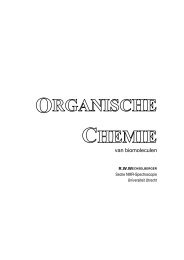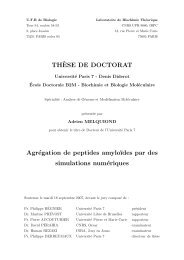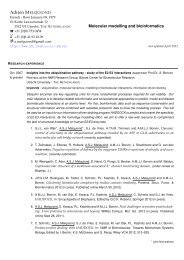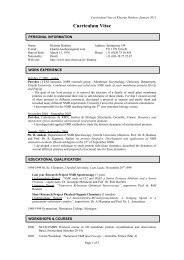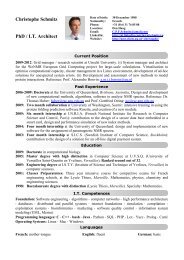Thesis Title: Subtitle - NMR Spectroscopy Research Group
Thesis Title: Subtitle - NMR Spectroscopy Research Group
Thesis Title: Subtitle - NMR Spectroscopy Research Group
Create successful ePaper yourself
Turn your PDF publications into a flip-book with our unique Google optimized e-Paper software.
102 Chapter 4. Protein Structure Determination from Pseudocontact Shifts using ROSETTA.<br />
4.1 Abstract<br />
Pseudocontact shifts (PCS) arise from paramagnetic metal ions bound to proteins and are<br />
manifested as large changes in chemical shifts detected in nuclear magnetic resonance (<strong>NMR</strong>)<br />
spectra. PCS data constitute long-range restraints on the positions of nuclear spins relative to the<br />
coordinate system of the magnetic susceptibility anisotropy tensor ( -tensor) of the metal ion.<br />
Protein structure determination using PCS data only, however, is hampered by the difficulty to<br />
determine the -tensor and metal position without knowledge of the protein structure. We have<br />
circumvented this problem in the program PCS-ROSETTA by using the structure prediction<br />
program ROSETTA to generate the models required for fitting of the -tensor parameters. PCS<br />
restraints implemented in the fragment assembly step of PCS-ROSETTA proved highly efficient in<br />
biasing the sampling of the conformational space towards the correct target structure. The results<br />
show that using a combination of chemical shift and PCS data, ROSETTA can determine structures<br />
accurately for proteins of up to 150 residues. Lanthanides can be incorporated into proteins quite<br />
generally through metal binding tags, and the combination of these data with the PCS-ROSETTA<br />
method provides a powerful new approach to protein structure determination.<br />
4.2 Introduction<br />
The three-dimensional (3D) structure of proteins is a prerequisite for understanding protein<br />
function, protein-ligand interactions and rational drug design. Protein structures can be readily<br />
determined by <strong>NMR</strong> spectroscopy. The most difficult part of an <strong>NMR</strong> structure determination<br />
typically is the assignment of sidechain chemical shifts and NOESY peaks. This bottleneck can<br />
potentially be avoided if methods for computing high accuracy structures from backbone-only<br />
<strong>NMR</strong> experiments can be developed.<br />
PCSs are a potentially rich source of structural information that are manifested as large<br />
changes in chemical shifts in the <strong>NMR</strong> spectrum caused by a non-vanishing magnetic susceptibility<br />
anisotropy tensor ( -tensor) of a paramagnetic metal ion. The PCS (in ppm) of a nuclear spin i<br />
depends on the polar coordinates ri, i, and i of the nuclear spin with respect to the -tensor<br />
frame of the metal ion and the axial and rhombic components of the -tensor:



